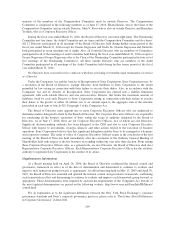Sony 2015 Annual Report Download - page 98
Download and view the complete annual report
Please find page 98 of the 2015 Sony annual report below. You can navigate through the pages in the report by either clicking on the pages listed below, or by using the keyword search tool below to find specific information within the annual report.Specifically, the amount of remuneration linked to business results shall be determined based upon
consolidated business results of Sony Corporation, such as operating income and the level of achievement in
respect of the business area(s) for which the relevant Corporate Executive Officer is responsible, and the amount
paid to Corporate Executive Officers shall fluctuate within the range from 0 percent to 200 percent, in principle,
of the base fixed remuneration amount.
Regarding the Phantom Restricted Stock Plan, points fixed every year by the Compensation Committee
shall be granted to Corporate Executive Officers every year during his/her tenure in office, and, at the time of
resignation, the remuneration amount shall be calculated by multiplying Sony Corporation’s Common Stock
price by the accumulated points. The resigning Corporate Executive officer shall purchase Sony Corporation’s
Common Stock with this remuneration.
C. Board Practices
Sony Corporation has adopted a “Company with Three Committees” corporate governance system under the
Companies Act of Japan (Kaishaho) and related regulations (collectively the “Companies Act”). Under this
system, Sony Corporation has three committees: the Nominating Committee, the Audit Committee and the
Compensation Committee. Under the Companies Act, each committee is required to consist of not fewer than
three Directors, the majority of whom must be outside Directors. In order to qualify as an outside Director under
the Companies Act, a Director must be a person who satisfies all of the following requirements (i) through (v):
(i) a person who is not a director of Sony Corporation or any of its subsidiaries engaged in the business
operations of Sony Corporation or such subsidiaries, as the case may be, or a Corporate Executive Officer or
general manager or other employee (“Group Executive Director, etc.”) of Sony Corporation or any of its
subsidiaries and who has not been a Group Executive Director, etc. of Sony Corporation or any of its subsidiaries
for ten years prior to assuming his/her office; (ii) if a person who has been a director, accounting counselor (if the
accounting counselor is a juridical person, a member who is in charge of the affairs), or corporate auditor of Sony
Corporation or any of its subsidiaries (excluding a person who has been a Group Executive Director, etc.) at the
time within ten years prior to assuming his/her office, a person who has not been a Group Executive Director,
etc. of Sony Corporation or any of its subsidiaries for ten years prior to assuming his/her office as a director, an
accounting counselor, or a corporate auditor; (iii) a person who is not a director or a Corporate Executive Officer
or general manager or other employee of a parent company or any entity which controls the management of Sony
Corporation; (iv) a person who is not an Group Executive Director, etc. of a direct/indirect subsidiary of Sony
Corporation or any entity the management of which is directly or indirectly controlled by Sony Corporation; and
(v) a person who is not a spouse or relative within the second degree of kinship of a director or a Corporate
Executive Officer or general manager or other employee of Sony Corporation.
Under the “Company with Three Committees” system, Directors as such have no power to execute the
business of Sony Corporation except for limited circumstances as permitted by law. The Board of Directors must
elect Corporate Executive Officers (Shikko-yaku), who are responsible for the execution of the business of Sony
Corporation. A summary of the governance system adopted by Sony Corporation is set forth below.
The Board of Directors determines fundamental management policy and other important matters related to
the management of Sony and oversees the performance of the duties of Directors and Corporate Executive
Officers. Furthermore, the Board of Directors has the power and authority to appoint and dismiss the members of
Sony Corporation’s three committees and Corporate Executive Officers. Under the Companies Act, Directors are
elected at the General Meeting of Shareholders from the candidates determined by the Nominating Committee.
Under the Companies Act, the term of office of Directors expires at the conclusion of the Ordinary General
Meeting of Shareholders held with respect to the last business year ending within one year after their election.
Directors may serve any number of consecutive terms although, under the Charter of the Board of Directors,
outside Directors may not be reelected more than five times without the consent of all Directors nor more than
eight times even if the consent of all Directors is obtained.
The Nominating Committee, which pursuant to the Charter of the Board of Directors consists of three or
more Directors, determines the content of proposals to be submitted for approval at the General Meeting of
Shareholders regarding the appointment and dismissal of Directors and evaluates the management succession
98
























